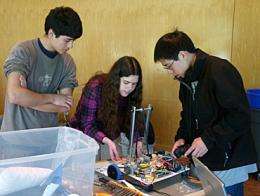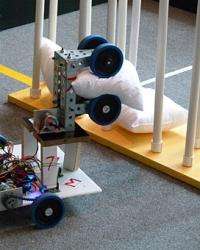A pillow fight on auto-pilot

The breezeway between McLaughlin and O’Brien halls looks like an electronic components store after an explosion. Color-coded wires, screwdrivers, white sprockets and power tools litter the floor—wherever there isn’t a student standing, squatting or lying.
In teams of fives and sixes, these local high school engineers are working hard to build robots for the final competition of Pioneers in Engineering (PiE), a robotics competition run by Berkeley Engineering students. In just a few days they’ll let their robots loose to see which one can load up the most small, white pillows and then maneuver as many as possible into a PVC goal.
It’s a seemingly daunting task, requiring patience, tinkering and creativity. But whether adding motors, replacing wheels or scrapping one idea for another, these student engineers have had a whole lot of fun making their robots work.
Founded by the Berkeley chapter of Tau Beta Pi, the engineering honor society, PiE is in its third year on campus. Like other robotics competitions, the program starts these high school teams out with a standard kit of materials and then provides coaching and support as they design their own unique robots.
But the PiE program also has a broader vision: to create an affordable introduction to engineering for high school students, with exposure to both mechanical and programming aspects. For Berkeley Engineering students, it’s a chance to build and teach.
“It’s an opportunity for COE students to do some of the engineering that pulled them into Berkeley Engineering in the first place,” says Ryan Julian, a third year electrical engineering and computer sciences (EECS) student and this year’s PiE director.
“PiE is the perfect opportunity to make an impact in the community,” adds Jessica Miller, a second year EECS major. “What motivated me was the chance to teach high school students about engineering and hopefully inspire them to pursue an engineering career.”

Miller was a mentor for El Cerrito High School’s team. Dennis Wai, a second year student in mechanical engineering, also mentored that team.
“Building a robot, even for an engineering undergrad, is difficult,” Wai says. “So many challenges pop up over the course of construction. Trying to console mentees after a setback was also surprisingly difficult.”
Each team starts with an 18-by-18-inch polyethylene board, wheels, two motor mounts and other basic parts. Also included in the kit is the all-important open-source board loaded with basic programming. Then comes the fun part: monkeying around.
As in all good engineering, no detail is too small. Glue foam padding to the edge of the board to protect components? Yes. Sandpaper or duct tape for the conveyor belt? Sandpaper lasts better. Remove tags from the pillows? Tags are clipped off to prevent snags.
As teams take turns testing their robots, it’s crowded and noisy, but a sense of order prevails. The team from Albany High sets up. Their design involves a sandpaper conveyor belt and a large flipper to launch the pillows up onto the sandpaper.
Jostling one another for a better view, students count down from three while one teammate mans the keyboard controls. On “go!” the robot takes the pillow and moves ahead in the right direction, but the flippers fail to toss the pillow up onto the conveyor belt.
Meanwhile El Cerrito High’s team is deep in discussion.
“We’re debating whether to install some bicycle chains to ease the rise and fall of the dustpan,” says El Cerrito High senior Laura Dolorfino. She uses a joystick to flip a plastic dustpan on her team’s robot back and forth. “We’re also a little concerned about the motor burning out.”
Just a few days later, it’s competition day. All 12 teams converge in Wozniak Lounge in Soda Hall, and many students look like they haven’t had much sleep.
As the competition gets underway, some robots crash while others just refuse to budge at all. But as robot after robot either fumbles pillows or places them squarely into the goal, loud cheers erupt from the gathered crowd.
In the end, one of Oakland Technical High’s teams takes the top prize as well as the mechanical design award. Another team from Oakland Tech receives the software and sensors award for electrical and software design. And Albany High’s team, with the tricky conveyor belt design, goes home with the engineering professionalism award for great teamwork.
Provided by University of California - Berkeley




















